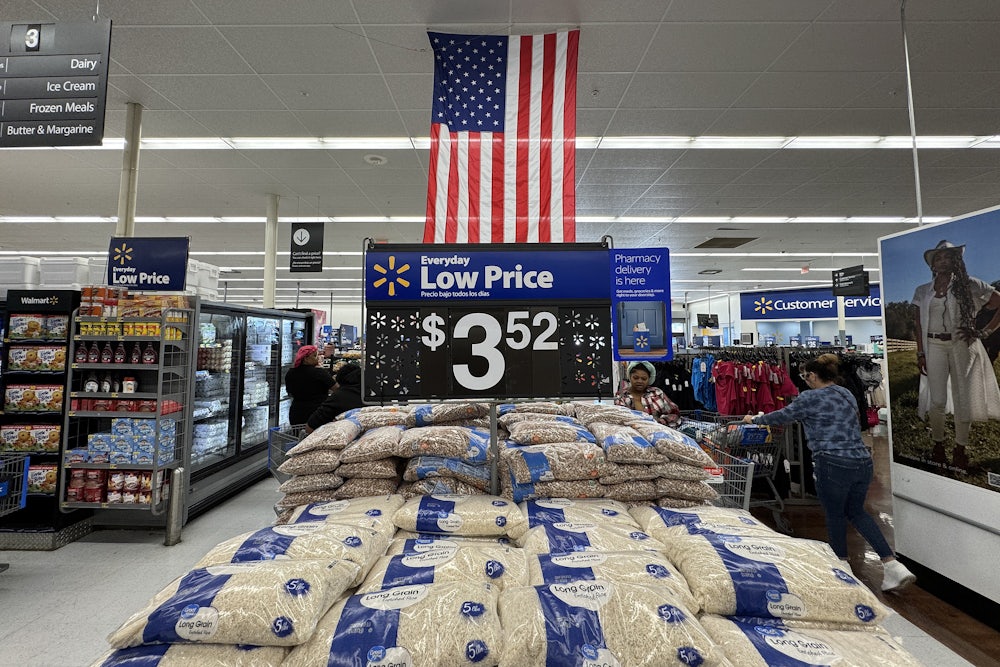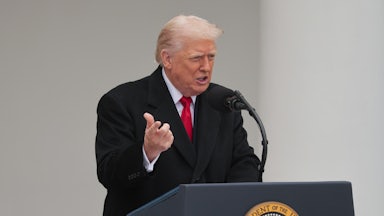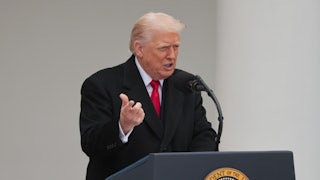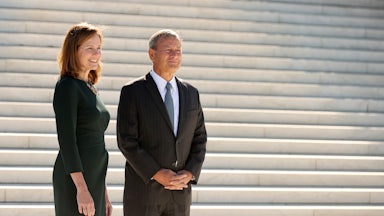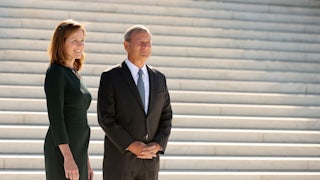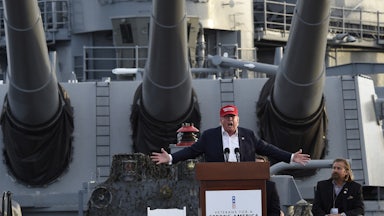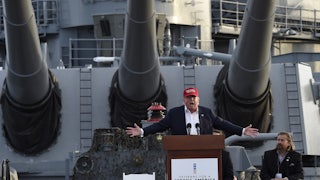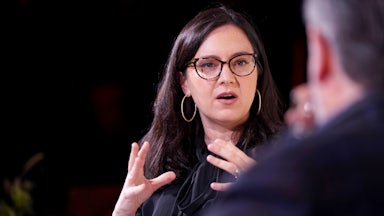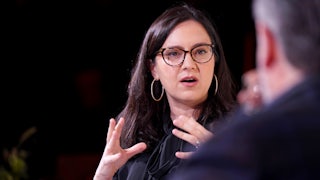While economists warn of a parade of economic horrors in the wake of President Donald Trump’s tariff-driven trade war, the president himself has tried to mitigate the news of the gathering calamity with some odd distractions. The administration keeps telling families to expect fewer dolls—a wan rationalization coupled with an attempt to associate concerns about high costs and product scarcity with frivolity and femininity. The consumers caught in the crossfire, however, shouldn’t get distracted and lose sight of what higher prices mean for their household budgets or stop watching how companies respond, particularly as the specter of a recession looms.
In one such instance of a firm responding to the pressures of Trump’s tariff regime, Amazon recently found itself crosswise with the Trump administration, which laid into the company after Punchbowl News reported that it was planning to show the impact of Trump’s economic plans by allowing shoppers to see for themselves what portion of an item’s total listed price could be chalked up to tariffs. White House press secretary Karoline Leavitt notably called this a “hostile and political act by Amazon,” which practically served as a declaration of war against the e-commerce giant.
Soon afterward, Amazon backed down: “The team that runs our ultra low cost Amazon Haul store considered the idea of listing import charges on certain products. This was never approved and is not going to happen.” President Trump later said he spoke to Jeff Bezos, founder and executive chairman of Amazon, after the report, telling reporters, “He solved the problem very quickly.”
The political firestorm raises a bigger question about how companies are approaching tariffs and what it means for consumers seeking accountability on pricing. While Amazon or other companies may plan to reveal some of the between-the-lines costs of Trump’s trade shenanigans, these may not actually offer clarity to consumers in the way they hope.
Lindsay Owens, executive director of Groundwork Collaborative, a progressive economic think tank, said that it seems straightforward for a company to simply add 10 percent to correspond with a 10 percent tariff surge, but it’s not that easy to understand the impact per product because you have no way of knowing if 100 percent of the good is tariffed at 10 percent or 50 percent of it is.
“Then 10 percent would be too high, so there’s really no accountability here,” she said. “Even folks who might try to run a play around more transparency with the tariff surcharge, to try to separate out which piece of the price hike is coming from the tariffs and which is not; you would still not know if that that was actually a reflection of increase in input costs on the part of the merchant or the retailer.”
This approach to pricing, which some experts call partition pricing, does not necessarily do anything to help consumers. A 2023 economic paper found that partitioned pricing leads to higher full prices and larger profits than all-inclusive pricing, which may explain why Amazon considered it to begin with.
Owens said that she’s skeptical that companies will eat a lot of the cost from tariffs to remain competitive to gain market share. Huge companies have not been shy to announce that their prices will go up as a result of tariffs, with Adidas, Walmart, Procter & Gamble, and food company Conagra Brands all preparing consumers for higher prices.
“I think they’re going to be passing along as aggressively as they can.… Somebody might have some scale and be able to run a volume play rather than a price play, and then you’d be in trouble if you were a competitor. But we have such concentrated markets. I just don’t think that that sort of race to the bottom dynamic is likely,” she said.
Lauren Saidel-Baker, a speaker and economist at ITR Economics, where she provides consulting services to companies, said she’s talking to clients about their approach to pricing and seeing more of them deciding to pass on costs to consumers.
“That’s going to be different for everyone, but I’ve started to feel more folks moving for ‘We just need to protect our margins and our labor costs more now; our inputs cost more; energy, electricity costs more.’ Just every cost is going up, so they’re much more focused on price, and we … see inflation coming back in the tail end of this year,” she said.
Saidel-Baker said ITR is recommending not to use a tariff surcharge because “everyone knows tariffs are here.” It also creates an issue for companies where consumers expect that surcharge to come off, and companies may want to keep it on to cover other costs, which could become a problem.
“With the surcharge, you expect it to eventually come off. If these costs are more broad-based, things like labor, electricity that probably won’t be getting much cheaper, you do need to take that price permanently,” she said.
Regardless of whether companies decide to use a not-so-reliable method of breaking down the impact to goods per item we buy, we have a broader idea of how tariffs affect households thanks to the Yale Budget Lab, which has broken out how all 2025 tariffs raise consumer prices by 2.3 percent in the short run, with a household loss of $3,800 in 2024 dollars. The tariffs will hit clothing prices particularly hard, raising them 17 percent for consumers, looking at the impact of all tariffs.
There is also the psychology of pricing to consider. Eric Johnson, the director of the Center for the Decision Sciences at Columbia Business School, said consumers don’t have a great memory of the price they paid for something—though there are some exceptions: Consumers have a fixation with the cost of milk, for example, and big-ticket purchases, such as automobiles, tend to stick in the memory. Nevertheless, he says research has shown that consumers don’t always like when fees are partitioned out.
“People love all-in-one pricing, and they hate it when fees are broken out. There’s psychology about that, but basically you can imagine paying for something twice. It’s painful compared to paying the total amount, and you see this all around you,” he said.
There are some cases in which consumers respond well to this pricing, research suggests: when the total price is absent, when shoppers perceive themselves as being offered some kind of high benefit, or other factors. But in the current economic climate, it’s not clear that many companies would realize enough benefits from a positive consumer response to partition pricing to make it worth all of the attendant political risk—this despite the fact that firms could, in theory, play a role in building political pressure against tariffs. Trump has made it clear he’ll be contacting CEOs if he disagrees with their decisions, after he was asked about his call to Jeff Bezos.
“Just imagine a few years ago if Amazon had decided to effectively cleave off the percentage of price hikes that were coming from inflation and start calling it, ‘Biden’s inflation,’” Owens said of the possible political impact an Amazon tariff charge would have had.
Saidel-Baker said she doesn’t think companies are going to take up Amazon’s aborted pricing plan, in the wake of the Trump administration’s furious response: “We saw what happened to Amazon when they tried to add that tariff line, and there can be political fallout. I think a lot of folks don’t want to take a political position in a way that could look more targeted,” she said.
But watchful consumers face another question: Will companies, whether they attempt some form of partition pricing or not, take advantage of consumers’ expectations about tariffs to engage in price gouging? Firms have taken advantage of environments where consumers expected higher prices before, even as their costs subsided. A January 2024 report from the Groundwork Collaborative found that from April to September 2023, corporate profits drove 53 percent of inflation, compared to profits driving 11 percent of price growth over the course of 40 years before the pandemic began.
Owens said that there’s no real accountability for companies that engage in price gouging. For this reason, Senator Elizabeth Warren has introduced legislation to make it illegal for companies to sell a good or service at a “grossly excessive price” and to require companies to explain shifts in pricing strategies. Warren has already expressed concern that tariffs will give companies a reason to jack up prices, telling CNBC in April, “That creates the environment for businesses to be able to say, ‘Oh, well, we’ll just go ahead and increase our prices now. We will increase our prices more than the cost of the tariffs.’”
John Lowrey, assistant professor of supply chain and information management and health sciences at Northeastern University, said companies’ ability to price gouge may depend on how long the economic disruption will ultimately last.
“When it’s shorter term, everyone is responding in this very acute sense, and they’re almost pricing in the uncertainty into the price that they provide the consumer,” he said. “When it’s chronic and longer term, there are more competitive dynamics at play whereby you can’t just raise prices by twofold because then consumers will seek alternatives. And there’ll be other firms that are not responding in price but instead responding by changing quality, or changing assortment, or changing availability, and you’ll start to lose customers because these competitive dynamics will play out.”
It’s hard to say when to expect more of the trade deals that Trump has been promising for weeks, aside from the deal with the U.K. the Trump administration announced Thursday. Trade experts say that the July 8 deadline for Trump’s 90-day pause on tariffs that went into effect in April does not offer enough time to make any kind of substantial trade deal, which more often than not takes years to iron out. In the short term, the economy is under threat.
“There is a 50 percent chance we have some kind of slowdown; 50 percent chance we have a recession, hypothetically,” said Michael Madowitz, principal economist at the Roosevelt Institute. “In either case, you might want policy to intervene more and we seem to have painted ourselves in a corner. It’s going to be really hard to do that right now.”
